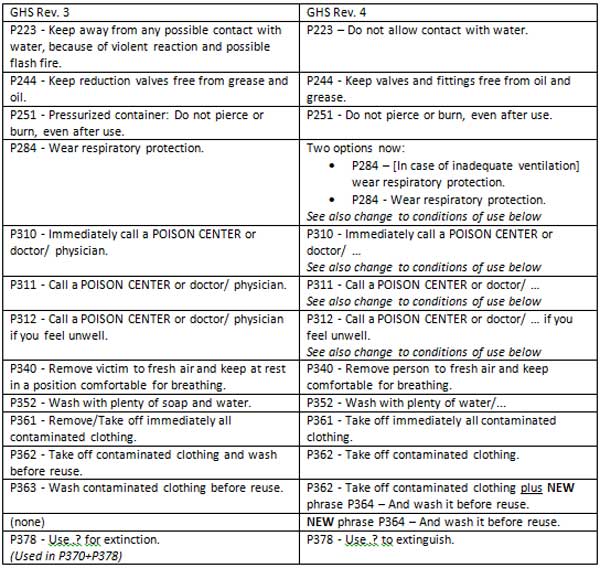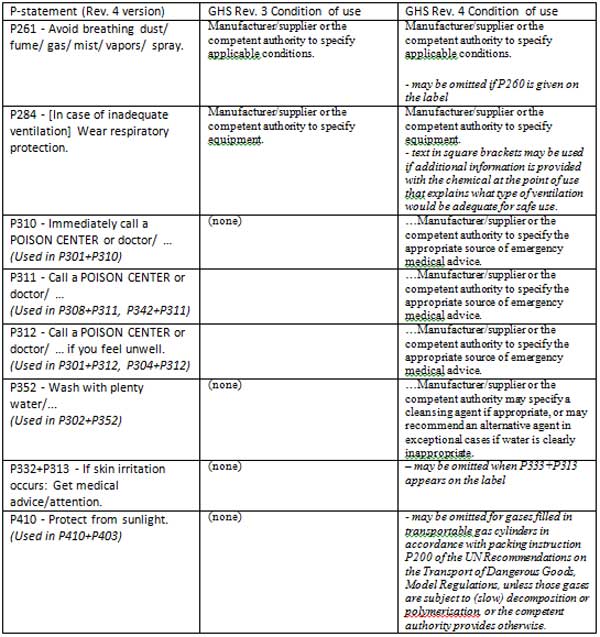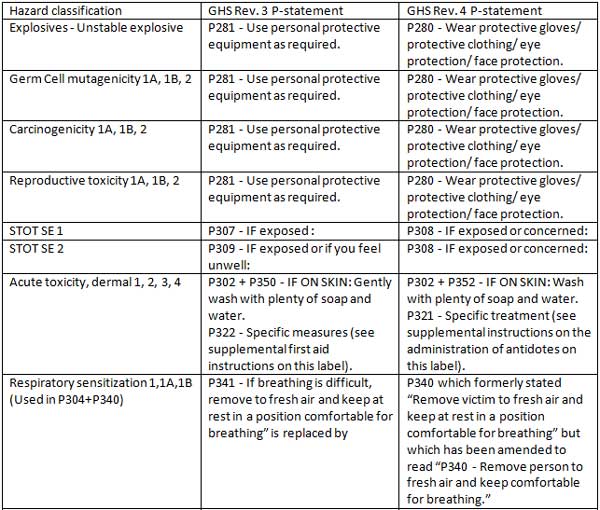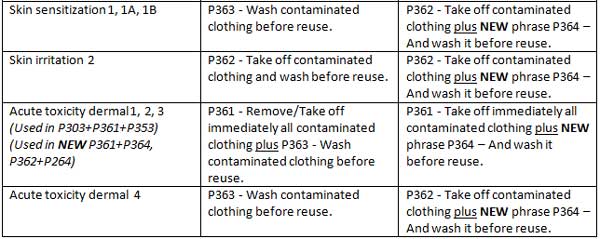Changes to expect from Revision 4 of GHS
The UN published the 4th biannual revision of the Globally Harmonized System of Classification and Labeling (GHS) in June 2011. The amendments to GHS primarily address “chemically unstable gases and non-flammable aerosols; further rationalization of precautionary statements, and further clarification of some of the criteria to avoid differences in their interpretation”. The amendments are given in a 71-page document, ST-SG-AC10-38a3e, and are summarized here.
Chemically unstable gases
The definition of “chemically unstable gases” describes a “flammable gas that is able to react explosively even in the absence of air or oxygen.”
Chapter 2.2 is amended to “Flammable gases (including chemically unstable gases).
Two categories, A and B, are added to the classification methods for chemically unstable gases. The categories are used together with the Flammable gas categories 1 and 2, and carry only a new hazard statement, without new symbols nor signal words.

The applicable precautionary statements are:
Flammable gases A,B (chemically unstable gases)
- P202 - Do not handle until all safety precautions have been read and understood.
Non-flammable aerosols
Chapter 2.3 is amended to “Aerosols” (instead of “flammable aerosols”).
A new hazard category, category 3, is added for non-flammable aerosols. NOTE that the GHS pictogram GHS04 (Gas; physical_label_07.png) does not apply to Category 3 aerosols although the UN transport symbol 2 (model 2.2; non-flammable, non-toxic gases) showing a gas bottle against a green background does apply.

The applicable precautionary statements for the new category Aerosols, Category 3 are:
- P210 - Keep away from heat/sparks/open flames/hot surfaces. - No smoking.
- P251 - Do not pierce or burn, even after use (P251 as revised in Rev. 4).
- P410 + P412 - Protect from sunlight. Do not expose to temperatures exceeding 50 °C/ 122 °F.
Further rationalization of precautionary statements
Unknown Toxicity (Acute oral/dermal/inhalation)
The phrase for indicating the unknown acute toxicity (health) is revised to show the unknown toxicity by route of exposure. The table below shows the Rev. 3 phrase and Rev. 4 phrase side-by-side for ease of comparison:
New or Revised P-statements
Some P-statements have been revised for ease of comprehension or more efficient application. The table below shows the Rev. 3 phrase and Rev. 4 phrase side-by-side for ease of comparison:
New or Revised Conditions of Use
The conditions for use for some P-statements have been revised for ease of comprehension or more efficient application. The table below shows the Rev. 3 phrase and Rev. 4 phrase side-by-side for ease of comparison:
Replaced P-statements
Some P-statements have been deleted and replaced by similar phrases.
- •“P281 - Use personal protective equipment as required” is replaced by “P280 - Wear protective gloves/ protective clothing/ eye protection/ face protection” in all applications.
- • "P307 - IF exposed:" and “P309 - IF exposed or if you feel unwell:” are replaced by “P308 - IF exposed or concerned:” in all applications. (P307+P311 and P309+P311 are also affected)
- • “P322 - Specific measures (see supplemental first aid instructions on this label).” is replaced by “P321 - Specific treatment (see supplemental instructions on the administration of antidotes on this label).”
- • “P341 - If breathing is difficult, remove to fresh air and keep at rest in a position comfortable for breathing” is replaced by P340 which formerly stated “Remove victim to fresh air and keep at rest in a position comfortable for breathing” but which has been amended to read “P340 - Remove person to fresh air and keep comfortable for breathing.”
The table below shows the effect on application of affected P-statements in Rev. 3 and Rev. 4 side-by-side for ease of comparison; only P-statements that have changed are shown (all others from Rev. 3 still apply): 

Clarification of criteria to avoid differences in their interpretation
Mixtures are understood not to have data on CMR effects, and are normally classified based on the component thresholds.
Competent authorities may make the corrosive pictogram optional on consumer products that are corrosive to metals but not to skin and/or eyes.
It is repeatedly clarified that aerosols should not be classified as flammable gases, gases under pressure, flammable liquids, nor flammable solids.
Classification of gases under pressure is clarified. In particular the condition of @20⁰C applies to the receptacle pressure measurement.
The tables for classification and hazard communication elements related to CMR properties are amended to further clarify the differences and similarities of Category 1A and Category 1B CMR effects.
Other miscellaneous changes
References are updated for oxidizing gases to current revisions of test methods.
Competent authorities are given the option to specify the unknown toxicity statements for acute and aquatic toxicities either on the label or on the SDS, or both.
Possible Errata
On GHS Rev.4 page 20, P352 is assigned to acute toxicity, dermal 1, 2, 3, and 4. In GHS Rev. 3 page 25, P350 is assigned to acute toxicity, dermal 1 and 2. Nowhere in the GHS Rev. 4 is the requirement to apply P350 to Acute toxicity, dermal 1, 2 rescinded.






